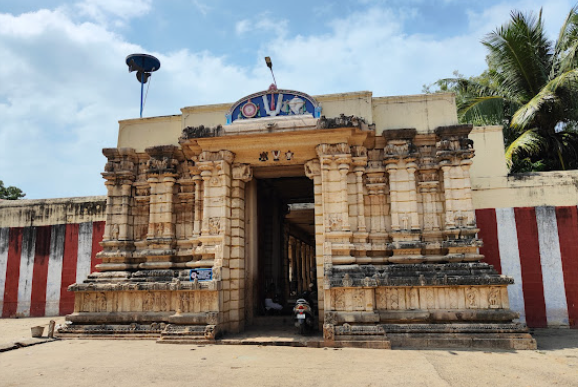A unique feature of the Thirupuliyangudi Perumal Temple is the depiction of a lotus stem that originates from the navel of Lord Perumal and extends upwards, connecting to a lotus flower with Lord Brahma, seen in the wall. Devotees can view the Feet of Lord Perumal through a window in the outer prakara. This temple is historically significant as the place where Indra was relieved of his Brahmmahati dosha. It is also where a Brahmin named Yagna Sharma, cursed by the sons of Sage Vasishta to become a demon, was freed from the curse. Additionally, Lord Perumal granted darshan to Varuna, Nirudhi, Dharmaraja, and Nara at this sacred site.
Sthala Puranam:
The legend of Thirupuliyangudi Perumal Temple revolves around several significant events and characters. The sons of Sage Vasishta, known as the Saptha Rishis, cursed a demon named Yagnasharma, who was well-versed in sacred knowledge. However, Yagnasharma was ultimately freed from his curse when he was touched by the sacred feet (Thiruvadi) of the deity, Emperumaan, in this temple.
Another tale involves Indra, the king of the Devas. Indra once disrespected his teacher, Devaguru Brihaspati, who then vanished as a result. To replace Brihaspati, Indra appointed Vicchuvaruna, the son of Sukiran (Venus), as the new guru to perform a yajna (sacred ritual) to strengthen the Devas. However, Vicchuvaruna, who had three heads, was secretly aligned with the demons (Arakkas) and used the yajna to empower them instead. When Indra discovered this through his divine vision (Gnana Eye), he decapitated Vicchuvaruna using his Vajrayudha (thunderbolt). The three heads of Vicchuvaruna transformed into an eagle, a vulture, and a crow, and were cast into the air. This act caused Indra to incur the Brahmahathi Dosham (sin of killing a Brahmin).
To atone for this sin, Indra received offerings of land, water, women, and trees from the other Devas, but the dosha persisted. Finally, Indra's curse was lifted only after he worshipped at this sacred site.
In general, Emperumaan (Lord Vishnu) is known for his calm and peaceful nature. However, to eradicate evil, he can take on a fierce form. At this temple, the presiding deity, Perumal, is also known as "Kaaichina Vendhan" due to his fierce aspect, which is reminiscent of Lord Shiva's character. This highlights the unity between Vishnu and Shiva, demonstrating that they are one and the same and should be revered equally.
A king should not be quick to anger, but if something threatens the welfare of his people, he must rise to protect them with force. Similarly, in this temple, Sriman Narayanan displays a fierce form to convey the importance of righteous anger when necessary. He grants his divine presence as "Kaaichina Vendhan" in Bhujanga Sayanam (reclining posture), helping those cursed, like Yagnasharma, and those suffering from Brahmahathi Dosham.
Inside the sanctum (Garbh Graham), from the stomach of Kaaichina Vendhan Perumal, a lotus stalk emerges, connecting to the image of Lord Brahma, who is depicted on the wall. Only one foot of Emperumaan is visible, but both feet can be seen through a small hole in the outer prakaram (corridor).
